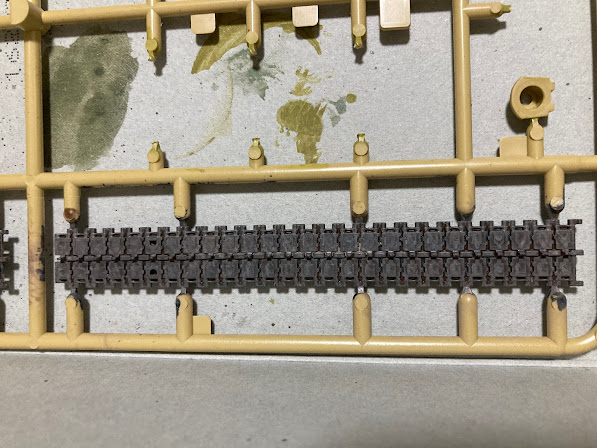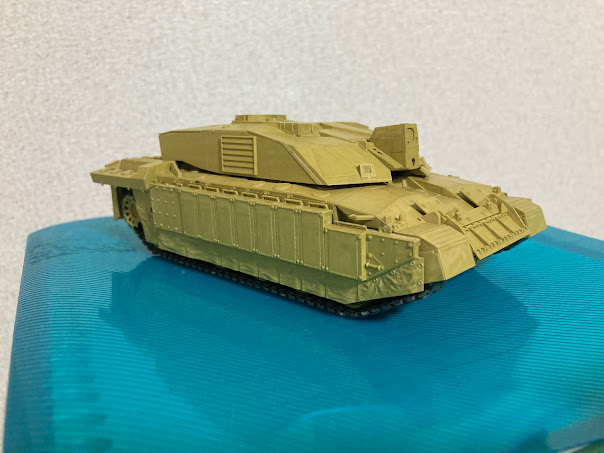ERA everywhere. Group build. Herbert Erpadorp Discord group.


It's time to build my ERA entry for our group build. 'ERA everywhere'.
The rules. Build something, anything with ERA. My challenge is a Challenger MkII
As always, you will see that I've pre-painted the sprues before I get going.
Building the lower hull. And adding the weight. No, I'm not doing the 'long weight' joke again.
I like the feeling the weight gives the model. As always, the Tamiya kit is so easy to put together.
Next up the wheels and the rear hull. The straightest of straight forward.
'Wheel meet again...' Painting the black tires in a really, really dark grey...
A bit of whittled sprue to hold the wheels while I paint the tires.
Adding the finished wheels to the hull.
Attaching the bulkheads. Does just what it says on the tin...
Dark grey rather than black...
Varied shades of brown.
And now I can build up the hull.
This is the ERA amour. The raison d'être of the group build.
Men with skirts. Nice.
Time for the turret.

Adding the fuel tanks.
Very little cleaning of seams and joints is necessary. Just a touch of emery cloth...
Notice the mistake?
I thought I might have this trouble...
Too big for the base... This beast is a big'un even in 1/48. Fortunately I have another somewhere...
Adding decals.
And we are about finished... Aerials, small details and a new base.
The commander has a panoramic SAGEM VS 580-10 gyrostabilised sight with laser rangefinder. The elevation range is +35° to −35°. The commander's station is equipped with eight periscopes for 360° vision.
The Thermal Observation and Gunnery Sight II (TOGS II), provides night vision. The thermal image is displayed on both the gunner's and commander's sights and monitors. The gunner has a stabilised primary sight using a laser rangefinder, with a range of 200 m (660 ft) to 10 km (6.2 mi). The driver's position is equipped with an image-intensifying Passive Driving Periscope (PDP) for night driving and a rear-view thermal camera.
Just make sure to follow the instructions...I know I said it earlier but it's still true.
Australian version.
All done.
Reactive armour is a type of vehicle armour, typically used to protect modern tanks against shaped charges and hardened kinetic energy penetrators. When a shaped charge strikes the upper plate of the armour, it detonates the inner explosive, releasing blunt damage that the tank can absorb.
Reactive armour can be defeated with multiple hits in the same place, as by tandem-charge weapons, which fire two or more shaped charges in rapid succession. Without tandem charges, hitting precisely the same spot twice is much more difficult. 'duh'
I'll be skipping some of the details for now to protect them from damage while I'm working on the other sections....
The nuclear, biological, and chemical (NBC) protection system is located in the turret bustle. The tank's shape is designed to minimise its radar signature. On each side of the turret are five L8 smoke grenade dischargers. The Challenger 2 can create smoke by injecting diesel fuel into the exhaust manifolds.
It really has gone together really smoothly.

Protection
The Challenger 2 is a heavily armoured and well protected tank. The turret and hull are protected by second-generation Chobham armour, also known as Dorchester, the details of which are classified but which is said to have a mass efficiency more than twice that of rolled homogeneous armour against high-explosive anti-tank (HEAT) projectiles. Crew safety was paramount in the design. It uses a solid-state electric drive for turret and gun motion, instead of hydraulic systems that can leak fluid into the crew compartment.
Painting the skirts. I'll use a khaki for this.
Adding the cupola and smoke dispensers.
Panel line shading with various shades of brown...
We need a gun and some machine gun support.
Armament.
The Challenger 2 is equipped with a 120-millimetre (4.7 in) 55-calibre long L30A1 tank gun,[12] the successor to the L11 gun used on Chieftain and Challenger 1. The gun is made from high strength electro-slag remelting (ESR) steel with a chromium alloy lining. Like earlier British 120 mm guns, it is insulated by a thermal sleeve. It is fitted with a muzzle reference system and fume extractor, and is controlled by an all-electric control and stabilisation system. The turret has a rotation time of 9 seconds through 360 degrees.
Uniquely among NATO main battle tank guns, the L30A1 is rifled and along with its predecessor, the Royal Ordnance L11A5, the only Third Generation Main Battle Tank Guns to use a rifled barrel. This is because the British Army continues to place a premium on the use of high explosive squash head (HESH) rounds in addition to armour-piercing fin-stabilized discarding-sabot (APFSDS) rounds. HESH rounds have a longer range (up to 8 kilometres or 5 miles further) than APFSDS, and are more effective against buildings and thin-skinned vehicles.
Forty-nine main armament rounds are carried in the turret and hull. These are a mix of L27A1 APFSDS (also referred to as CHARM 3), L31 HESH and L34 white phosphorus smoke rounds, depending on the situation. As with earlier versions of the 120 mm gun, the propellant charges are loaded separately from the shell or KE projectile. A combustible rigid charge is used for the APFSDS rounds and a combustible hemicylindrical bag charge for the HESH and smoke rounds. An electrically fired vent tube is used to initiate firing of the main armament rounds. The main armament ammunition is described to be "three-part ammunition", consisting of the projectile, charge and vent tube. The separation of ammunition pieces aids in ensuring lower chances of unfired ammunition detonating prematurely.
Adding the machine gun and the rest of the details
The Challenger 2 is also armed with a L94A1 EX-34 7.62 mm chain gun coaxially to the left of the main gun, and a 7.62 mm L37A2 (GPMG) machine gun mounted on a pintle on the loader's hatch ring. 4,200 rounds of 7.62 mm ammunition are carried. The Challenger can also mount a Leonardo "Enforcer" remote control weapons system, bearing a 7.62 mm L37A2 (GPMG) machine gun, a 12.7 mm heavy machine gun or a 40 mm automatic grenade launcher.
Time to apply the decals.
Maximum speed: 37 mph (60 km/h) on road; 25 mph (40 km/h) cross country
Range: 342 mi or 550 km on road with external fuel; 156 mi (250 km) cross country on internal fuel.
By 2013 the British Army had, at various events featuring the Challenger 2, begun to state the on-road range as 550 km as opposed to an earlier stated value of 450 km. They also publicly stated a maximum road speed of 59 km/h while equipped with 15 tons of additional modules.
The commander has a panoramic SAGEM VS 580-10 gyrostabilised sight with laser rangefinder. The elevation range is +35° to −35°. The commander's station is equipped with eight periscopes for 360° vision.
The Thermal Observation and Gunnery Sight II (TOGS II), provides night vision. The thermal image is displayed on both the gunner's and commander's sights and monitors. The gunner has a stabilised primary sight using a laser rangefinder, with a range of 200 m (660 ft) to 10 km (6.2 mi). The driver's position is equipped with an image-intensifying Passive Driving Periscope (PDP) for night driving and a rear-view thermal camera.
As you can see, I haven't modelled the smoke and dust...
For me, I am happy with the result. I'm not going to be winning any prizes but that's not my goal.
Only in the UK...
Challenger 2 tanks require two sets of tools, as the hull is built using imperial measurements and the turret is built to metric measurements.
A nice result built with just a few materials and on a sensible budget. Modelling anyone can aspire too.
ERA everywhere. Group build. Herbert Erpadorp Discord group.


























































Comments
Post a Comment